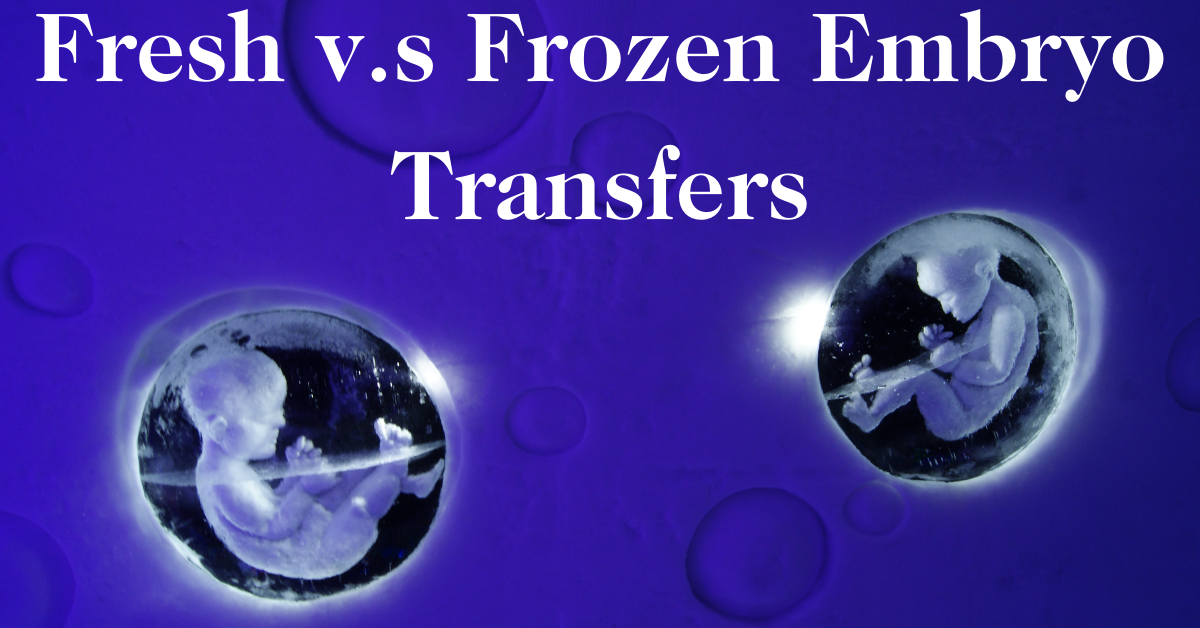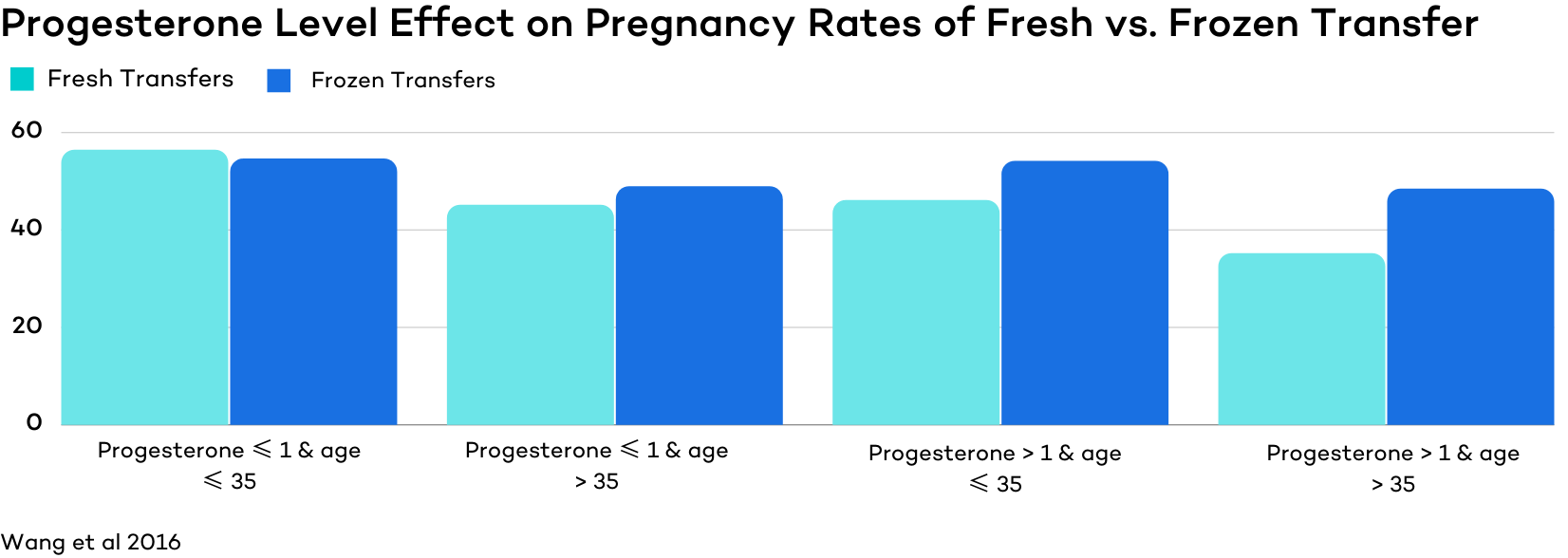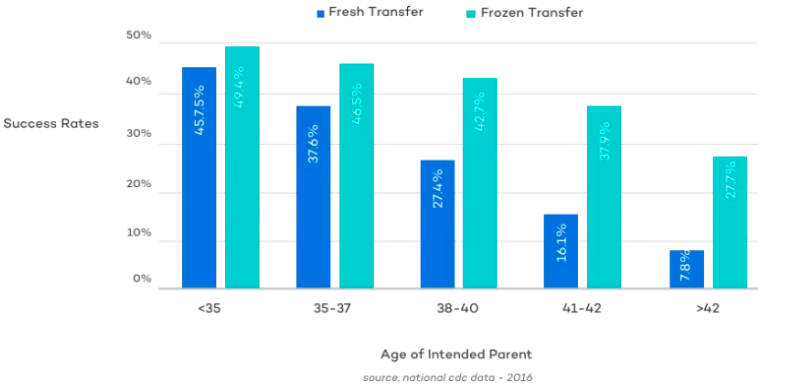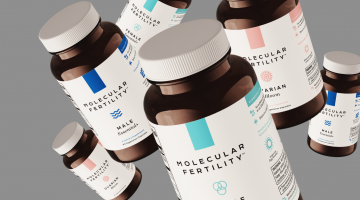Fresh and Frozen Embryo Transfers

The embryo transfer is the process of gently depositing an IVF embryo into the uterus of the intended parent, or in some cases, a gestational carrier. It is one of the most important steps when undergoing in-vitro fertilization (IVF) treatment, and interestingly, there are many different types and classifications of transfers. But arguably, the biggest and most important difference of all embryo transfer types is the distinction between a fresh and frozen embryo transfer.
Because of its importance in the schedule of your treatment, success rates, cost, the ability to perform add-on services like genetic testing, and more, it is important to understand the benefits and compare the differences between fresh and frozen embryo transfers.
During the first few decades of IVF treatment, fresh embryo transfers were viewed as superior and produced significantly greater success rates. However, since then, the process of freezing and thawing embryos, known as vitrification, has significantly improved.
Nowadays, the choice to perform a fresh vs. frozen transfer is much more nuanced.
This article will explain the difference between fresh and frozen embryo transfers, look at the success rates for each respective transfer type, and break down the benefits of both procedures so that you can have an informed conversation with your fertility specialist.
Fast Facts
- After the retrieval portion of the IVF process, embryos are fertilized and incubated so they can develop. After the embryos reach a specified cell stage, they can either be transferred (fresh transfer), or they can be frozen and used later (frozen transfer).
- Fresh embryo transfers have the potential to provide a faster time to pregnancy than frozen transfers as they are completed within one cycle. Frozen transfers take longer as they do not take place in the same cycle as the retrieval.
- A single fresh embryo transfer cycle is usually cheaper than completing an IVF cycle and a separate frozen transfer cycle. Since fresh transfers are completed within one cycle, they only require one round of medications. Frozen transfers usually require two medicated cycles, one round of stimulation medications during the initial retrieval cycle, and another round to prime the endometrium and increase receptivity prior to the embryo transfer. The cost of frozen transfers commonly includes other fees as well.
- Not all women’s bodies are immediately ready to receive an embryo after taking stimulation medications. Some women’s bodies require additional time for their hormone levels to balance and their uterine environment to become receptive to an embryo. Frozen embryo transfers allow women to take additional time to recover between their retrieval and transfer.
- Fresh and frozen embryo transfers can be used with donor eggs or embryos and with previously frozen eggs. Only frozen transfers can be used after embryo freezing cycles or if genetic testing or gender selection is completed.
What is an Embryo Transfer?
An embryo transfer is the final step of the In Vitro Fertilization (IVF) process. During an embryo transfer, the fertilized egg (embryo) is carefully loaded into a catheter, passed through the vagina and cervix, and deposited into the uterus.
After fertilization, embryos develop in the embryology lab for 3-7 days (typically 3-5 days). At this time, the embryos are either frozen (and await a frozen embryo transfer in some subsequent month) or transferred “fresh.”
What is a Fresh Embryo Transfer?
A fresh embryo transfer is just as it sounds. During a fresh transfer, the embryo is transferred back into the uterus without ever being frozen. A fresh embryo transfer usually occurs 3-5 days after the IVF egg retrieval.
What is a Frozen Embryo Transfer?
A frozen embryo transfer (FET) is a cycle in which frozen embryos from a previous IVF or donor egg cycle are thawed and then transferred into a woman’s uterus. Frozen embryo transfers can be completed the month after the retrieval cycle or even decades after a woman’s eggs have been retrieved and fertilized with sperm.
Fresh vs. Frozen Embryo Transfer Calendars
Fresh Embryo Transfer Calendar
A fresh transfer cycle takes place 3-7 days after the Egg Retrieval and thus can be considered part of the same IVF treatment cycle. Day 1 on the calendar below is the first day of IVF stimulation medications. If a woman has a normal menstrual cycle this the first day of meds is usually between days 2-4 of the woman’s natural cycle.
After that, women typically continuing taking stimulation medications for around 8-12 days. The results of ultrasound and bloodwork monitoring appointments will determine how many days of stimulation are required, which dictates when the egg retrieval takes place.
After the egg retrieval, the eggs are then fertilized with sperm via conventional or intracytoplasmic sperm injection (ICSI) fertilization. After fertilization, the embryos are placed in an incubator to develop. Embryos develop at different rates, so incubation times vary, but most embryos are ready for a fresh transfer after 3-7 days. Check out a sample fresh embryo transfer calendar below and click here to learn about the entire IVF process.

Frozen Embryo Transfer Calendar
The timing or frozen embryo transfer schedules is also dependent upon the intended parent’s cycle. Frozen embryo transfer timing is determined by lining development and response to stimulation medications (if being used).
Women are given estrogen and progesterone medications during a typical frozen embryo transfer cycle, known as endometrial priming. These medications help artificially prime the endometrium, which creates an ideal environment for an embryo to be transferred into.
Bloodwork and ultrasound monitoring appointments allow fertility specialists to check hormone levels and view the uterus to ensure the endometrial lining is developed appropriately and will be receptive to an embryo. Check out a sample fresh embryo transfer calendar below:

Of course, this typically comes after an egg retrieval cycle in which a fresh transfer did or did not take place.
Choosing between Fresh and Frozen Embryo Transfers
There are many variables to consider when choosing between fresh or frozen embryo transfer. One of the main considerations is how the patient responds to and how her body recovers from the stimulation medications she is given leading up to her egg retrieval.
Fertility specialists can check hormone levels like progesterone and estrogen with a blood test and also use ultrasounds to check the status of the endometrial lining to determine if a fresh or frozen transfer is recommended. If the patient’s hormones are balanced and her lining looks good, then most women can undergo a fresh transfer with confidence in their potential success rates, along with other positives like time, money, and insurance considerations.
If a patient’s hormones are out of balance, her lining isn’t optimally receptive, or she experiences hyperstimulation, then a frozen transfer will likely be recommended.
Because every patient reacts differently to stimulation medications, a patient-centered approach that treats each patient individually is the best way to decide between a frozen and fresh transfer.
When to Choose a Fresh Transfer
As mentioned above, fresh and frozen transfers boast extremely similar success rates for women who don’t require additional time for their bodies to recover after their retrieval. Check out the figure below to see just how similar fresh and frozen transfer success rates are for women with a progesterone level under one at the time of their transfer.

At CNY we generally take things a step further and look at both the progesterone and estrogen levels on the day of trigger. If both progesterone is under 1.5 and estrogen is under 3,000 then a fresh embryo transfer is most often a reasonable decision and tends to have very similar success rates, perhaps even better than frozen transfers.
The similarity in success rates, along with the additional reasons below, explain why so many women choose to complete a fresh transfer just a few days after their retrieval.
Time
Fresh embryo transfers can result in a significantly faster time to pregnancy than frozen embryo transfers. This is because fresh embryo transfers take place within one treatment cycle and are completed immediately after embryos reach the desired stage of development. This can be highly beneficial, especially for patients traveling for treatment as both the retrieval and transfer can take place in one trip spanning 5-7 days.
Frozen embryo transfers generally require two treatment cycles on behalf of the intended parents, one to produce the embryos and the other to prepare the body for transfer. Frozen transfers take place at least one month after the egg retrieval but can be done much later as well.
The exception to this would be if donor gametes are used. More on that later.
Money
If you are undergoing a full IVF cycle, including stimulation and retrieval, then it is most economical to undergo a fresh embryo transfer. Usually, fresh embryo transfers are included in the total cost of an IVF package, whereas frozen embryo transfers are charged separately.
Frozen embryo transfer cycles often require the use of two rounds of medications. The first cycle, in which the embryos are created, uses stimulating medications to increase the number of eggs produced prior to the retrieval. During the second cycle, the cycle in which the embryo from the previous cycle is transferred, a second round of medications is usually used (like estrogen or progesterone) for endometrial priming.
In addition to the cost of extra medications, the total cost of an IVF cycle with a frozen embryo transfer may also include additional charges for monitoring, embryo freezing, embryo storage, and thawing fees.
Insurance Considerations
Most insurance plans do not cover the cost of cryopreservation or other associated fees with frozen embryo transfers. Additionally, most insurance plans (if they cover IVF at all) have a limit on the number of cycles they cover. A frozen embryo cycle completed without an egg retrievals counts toward the limit on IVF coverage the same as a complete IVF cycle.
As such, it is more economical to complete multiple fresh transfer cycles to increase the number of quality embryos produced.
When to Choose a Frozen Transfer
If a woman experiences hyperstimulation or responds poorly to the stimulation medications used during her treatment, then she may benefit from freezing her embryos and allowing her body additional time to recover. Most women’s bodies recover and they are ready to complete their frozen transfer by their next cycle.
In 2018, the Center for Disease Control (CDC), published a report reviewing the results of 263,577 assisted reproductive technology cycles that were completed in 2016. The report included data on fresh embryo transfers and frozen embryo transfers and the results of each cycle for several different age groups.
The percentage of transfers that resulted in live births for both fresh and frozen embryo transfers at several different age groups are displayed in the figure below:

As you can see, overall, the success rates for this study were higher for frozen compared to fresh transfers.
** Please note, the above data does not account for any of the nuances seen in a patient-centered approach looking at critical lab values. It is therefore likely that the data here is largely skewed from patients undergoing a fresh transfer despite elevated progesterone and estrogen levels indicating a frozen transfer is the preferred option.**
Endometrial Receptivity Concerns
Research published by the American Society for Reproductive Medicine (ASRM) supports the CDC study findings in favor of frozen transfer cycles. ASRM concluded that the success of FETs is likely caused by the improved endometrium receptivity that is achieved in endometrium preparation cycles.
Additional research has shown that endometrial development can be controlled more precisely during FET cycles than in fresh transfer cycles that use gonadotropin medications. Improved endometrial receptivity is one of the main reasons that frozen embryo transfer cycles produce great success rates than fresh transfers.
Endometrium receptivity is of special concern for women whose bodies are sensitive to stimulation medications or experience hyperstimulation before or after their retrieval. These medications can cause biological stress, which causes hormonal imbalances and reduces uterine receptivity. FETs allow women to take additional time for their bodies to recover after their egg retrieval.
If a woman’s body is sensitive to stimulation medications and their hormones are imbalanced or their endometrium doesn’t develop as desired, then fertility specialists will likely recommend the woman freezes her embryos to increase the chances of a successful transfer. Most women’s bodies will have recovered, and the uterus will be better prepared to receive an embryo during her next cycle. During her next cycle, she will likely be given a combination of estrogen and progesterone to prime her endometrium and create a receptive environment for her embryo(s) to be transferred into.
In more extreme cases, like if hyperstimulation occurs, women will require additional time to recover.
Hyperstimulation Concerns
Ovarian Hyperstimulation Syndrome (OHSS) can cause a woman’s ovaries to swell and potentially leak fluid into the body. OHSS is most common in young women (or those with high AMH levels) and women with PCOS, but it can occur during any IVF cycle.
If a woman experiences hyperstimulation during the IVF process, her embryos are almost always frozen and transferred at a later time after her body has recovered.
Genetic Testing
Preimplantation Genetic Testing (PGT) takes place in unison with an IVF cycle. After embryos develop and reach the blastocyst stage, they are frozen and sent for testing. At this time, the speed of the vitrification process and the amount of time it takes for genetic testing to occur requires that embryos are frozen.
Embryos are tested for several reasons, including screening for genetic abnormalities or for gender selection.
Multiple Attempts (multiple embryos created from IVF stimulation)
IVF cycles can result in multiple embryos being created. Embryos that aren’t transferred via a fresh transfer can also be frozen and saved for later use. FET(s) provide women with multiple chances to get pregnant from one IVF stimulation cycle and retrieval. Basically, why go through another expensive IVF egg retrieval if you don’t have to?
Embryo Freezing
FETs provide women the opportunity to freeze embryos until they are ready to use them at a later time. Embryo freezing is wonderful for couples or women using sperm donors who know they want to have children later in life but aren’t quite ready. By freezing embryos, women or couples can effectively preserve their fertility for the future.
Either or, Fresh or Frozen
Some clinics (including CNY Fertility) accommodate the patient’s choice whether they would like to use a fresh or frozen transfer after egg freezing or while using donor eggs/sperm. If you plan to use frozen eggs or use donor eggs/ sperm, it is nice to have options.
Egg Freezing
As time goes on, more and more women are choosing to preserve their fertility and for many different reasons. For example, women may choose to preserve their fertility to pursue advanced education, demanding careers, or other avenues that make finding time to have and care for a baby extremely challenging. Other women freeze their eggs due to certain life events or after they receive a medical diagnosis that could potentially affect their fertility.
Whatever the reason a woman undergoes fertility preservation, we are here to help when they are ready to get pregnant.
Donor Eggs/ Donor Embryos
Donor options allow women who wouldn’t be able to get pregnant on their own the opportunity to have a baby. Age, diminished ovarian reserve, medical conditions, or prior medical treatments can all cause infertility and prevent a woman from being able to have a baby of her own.
If you are using donor eggs or donor embryos and prefer to choose between utilizing a fresh or frozen transfer, be sure to check with your clinic and ensure they accommodate both options.
In Conclusion
There is no one size fits all approach when choosing a fresh or frozen embryo transfer. Fresh embryo transfers prevent certain benefits for some women, and frozen embryo transfers provide different benefits for others. The correct approach for an individual patient can depend on a variety of factors that can occur before or during their IVF process.
At CNY Fertility, we encourage patients to speak with their fertility specialist about the benefits of both to determine if a fresh or frozen embryo transfer is right for them.




